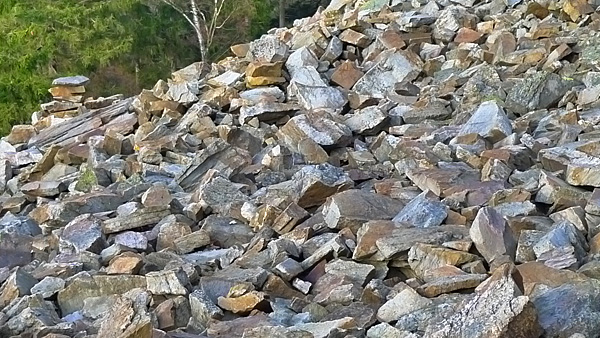White Wall EarthCache
-
Difficulty:
-

-
Terrain:
-

Size:  (other)
(other)
Please note Use of geocaching.com services is subject to the terms and conditions
in our disclaimer.

Die Weiße Mauer ist ein diluviales Frostschuttmeer aus Taunusquarzit auf 634 m Höhe. Sie gehört zum Naturschutzgebiet Altkönig rund um den dritthöchsten Berg im Taunus.
Als Teil des Rheinischen Schiefergebirges gehört der Taunus zu den älteren Gebirgen Deutschlands, deren Gesteine überwiegend aus dem Devon stammen und im Rahmen der variskischen Gebirgsbildung verfaltet wurden.
Quarzite sind fein- bis mittelkörnige metamorphe Gesteine, die mit Quarzgehalten ab 98 Prozent definiert sind. Sie zeichnen sich durch relativ große Beständigkeit gegenüber Umwelteinflüssen aus. Reiner Quarzit besitzt in vielen Fällen eine weißgraue oder weiße Farbe, so etwa der aus Italien stammende Silberquarzit. Gelbe und rote Farben werden durch Beimengungen von Eisenmineralien verursacht. Die häufig vorkommenden gelben Varianten werden durch das oft in den Ursprungsgesteinen vorhandene Mineral Limonit verursacht. Durch Verunreinigungen von Magnetit und Pyrit ist Quarzit manchmal auch braun oder grau gefärbt, seltener sind Farben wie dunkelgrün oder graublau. Das Mineral Dumortierit oder Kyanit färbt die Quarzite bläulich bis blau. Quarzit besteht im wesentlichen aus miteinander verbundenen, rekristallisierten Quarzkörnern, die durch Drucklösung an den Korngrenzen versintert sind. Je nach Methamorphosegrad können zum Teil sehr harte und spröde Gesteine entstehen, bei schwach metamorphen Quarziten kann es jedoch durchaus zu geringer Abrieb- und Frostresistenz kommen.
Bitte die Antworten der folgenden Fragen über mein GC Profil zusenden, du kannst den Earthcache danach loggen. Sollten deine Antworten falsch sein, melde ich mich bei dir. Bitte keine Antworten im Log posten.
1. Woher kommt der Name "Weiße Mauer"?
2. In welcher geochronologischer Periode (System/Serie/Stufe/Alter in Mio. Jahren) entstand der Taunusquarzit?
3. Bitte poste ein Bild von der Weißen Mauer mit dir oder deinem GPS etc. Das Foto kann auch per message an den CO gesendet werden. Warte in diesem Fall bitte die Logfreigabe des Owners ab.)
Logs die nicht den o.g. Anforderungen genügen, müssen leider gelöscht werden. Vor Ort gibt es übrigens kein Hinweisschild mit den Antworten.
Genieße die tolle Aussicht! Bitte beachtet die Naturschutzgebiet Regeln, offizielle Wege müssen zu keiner Zeit verlassen werden. Wer möchte, kann den Cache auch gut mit einem Besuch des White Wall Multi-Cache verbinden.

[ENG]
The White Wall is a diluvial frost detritus area of special quartzite ("Taunusquarzit") at 634m altitude. This area belongs to the nature-sanctuary "Altkönig" (Old King), the third-highest Taunus mountain.
The Taunus as part of the Middle Rhine Highlands ("Rheinisches Schiefergebirge") is one of the older mountains in Germany, with rocks mostly built during the geologic Devon period and has been folded in the context of the variscan orogeny.
Quartzite is a hard metamorphic rock which was originally sandstone. Sandstone is converted into quartzite through heating and pressure usually related to tectonic compression within orogenic belts. Pure quartzite is usually white to grey, though quartzites often occur in various shades of pink and red due to varying amounts of iron oxide. Other colors, such as yellow and orange, are due to other mineral impurities. When sandstone is metamorphosed to quartzite, the individual quartz grains recrystallize along with the former cementing material to form an interlocking mosaic of quartz crystals. Most or all of the original texture and sedimentary structures of the sandstone are erased by the metamorphism. Minor amounts of former cementing materials, iron oxide, carbonate and clay, often migrate during recrystallization and metamorphosis. This causes streaks and lenses to form within the quartzite. Quartzite is very resistant to chemical weathering and often forms ridges and resistant hilltops. The nearly pure silica content of the rock provides little to form soil from and therefore the quartzite ridges are often bare or covered only with a very thin soil and little vegetation.
Send the answers to the following questions to me through my geocaching profile. DO NOT post the answers to any logging requirements on this site. I will only respond if you have incomplete logging requirements. Go ahead and log the earthcache.
1. Where comes the name "White Wall" from?
2. From which geologic period (system/series/stage/age in mya) is the "Taunusquarzit"?
3. Please post a photo of the White Wall including you or your GPS.
Unfortunately, any log that does not meet the requirements will be deleted. Please note there is no sign on site to answer the questions.
Enjoy the great view! Please respect the nature-sanctuary, you don't need to leave official trails. You can solve the cache in conjunction with the White Wall Multi-Cache.

Additional Hints
(No hints available.)